
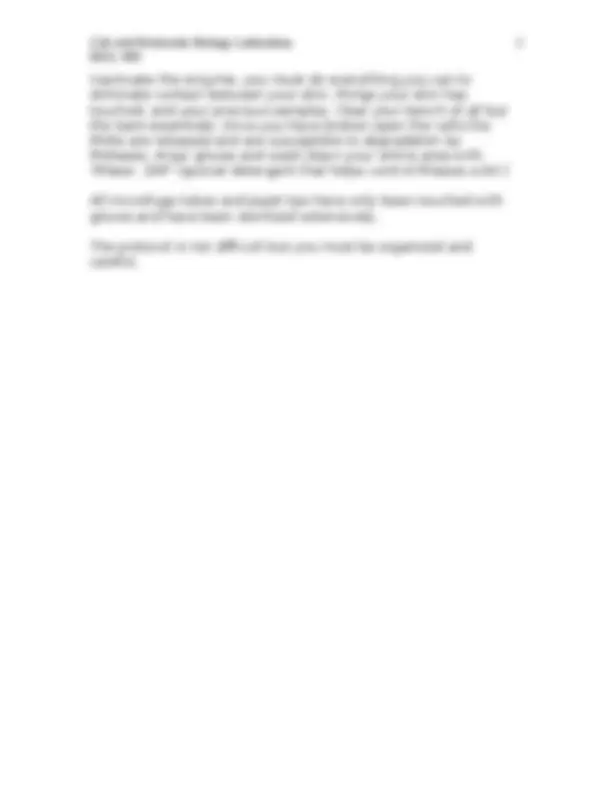
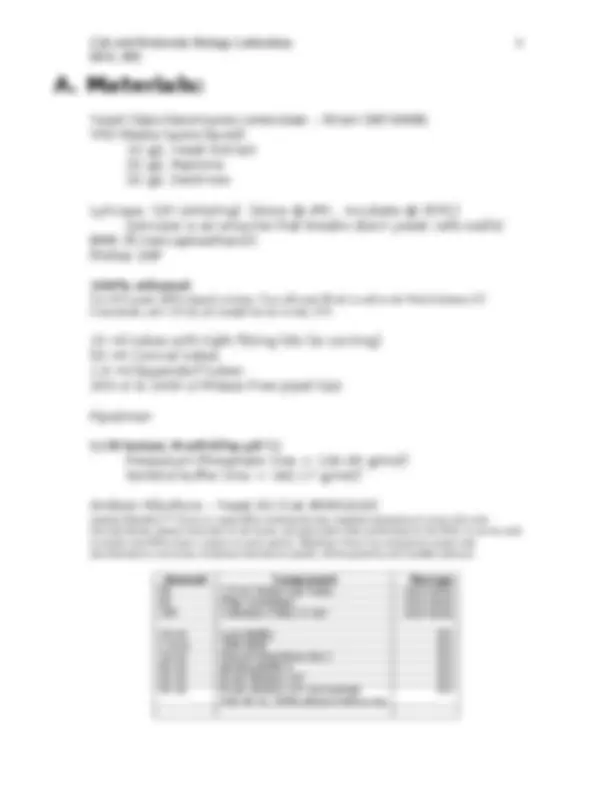
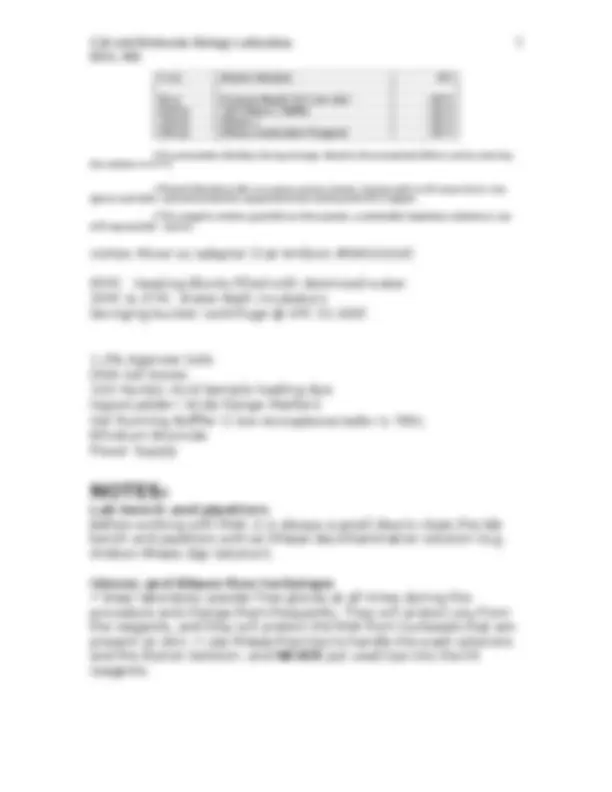
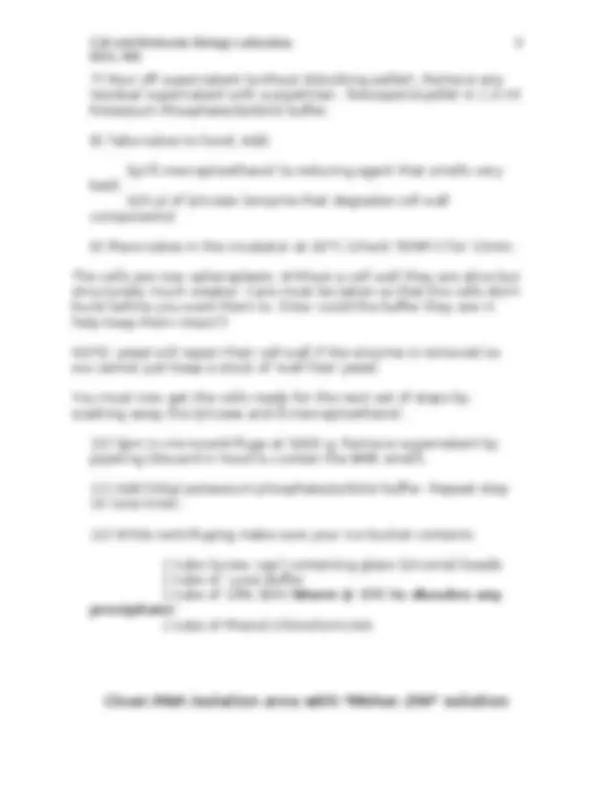
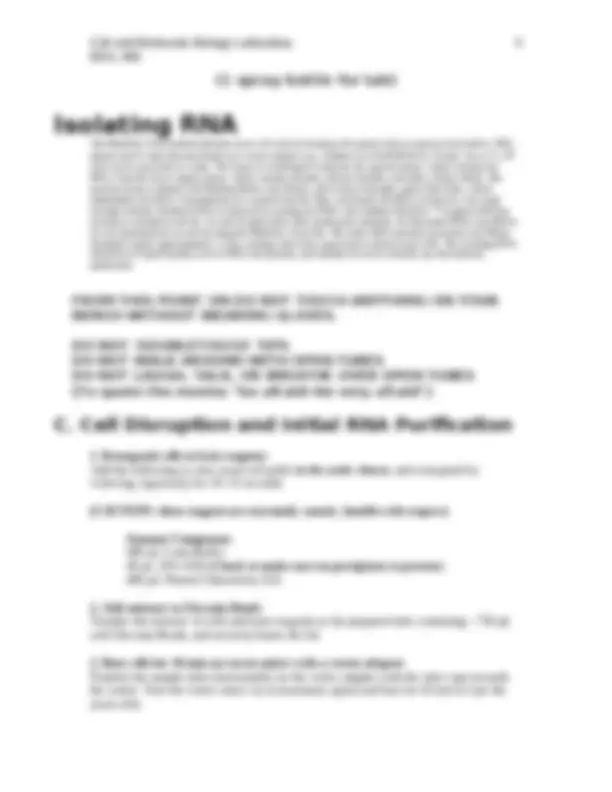
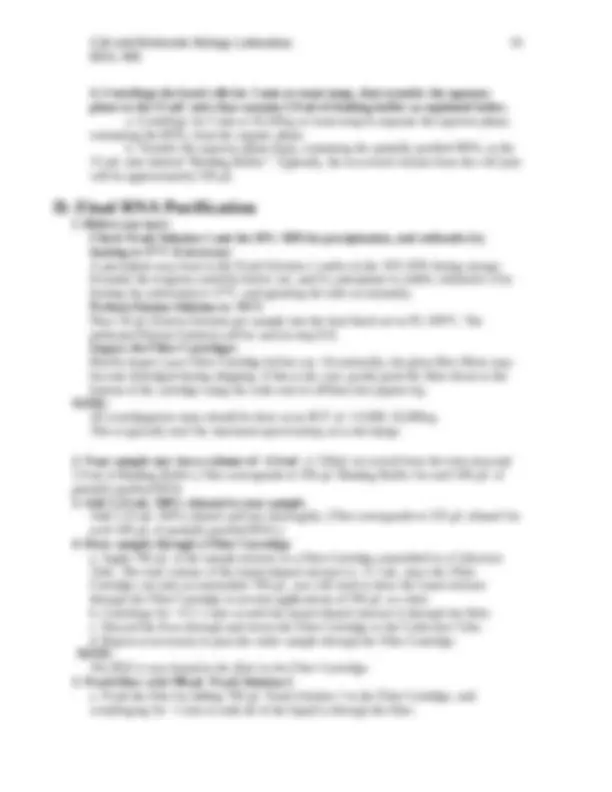



Study with the several resources on Docsity

Earn points by helping other students or get them with a premium plan


Prepare for your exams
Study with the several resources on Docsity

Earn points to download
Earn points by helping other students or get them with a premium plan
Community
Ask the community for help and clear up your study doubts
Discover the best universities in your country according to Docsity users
Free resources
Download our free guides on studying techniques, anxiety management strategies, and thesis advice from Docsity tutors
Material Type: Lab; Class: CELL AND MOLECULAR BIOLOGY: LECTURE AND LAB; Subject: Biology; University: Ramapo College of New Jersey; Term: Unknown 1989;
Typology: Lab Reports

Limited-time offer
Uploaded on 08/18/2009
5
(1)10 documents
1 / 13

This page cannot be seen from the preview
Don't miss anything!









On special offer
BIOL 406
(This protocol revised&adapted from Dr. Karen Bernd, at Davidson College, N.C.) Objectives:
RNA expression is one way of measuring gene activity. As genes are turned on, mRNA levels for those genes increase, generally resulting in increased protein expression. While cells have many ways of regulating proteins, differences in the functional state of the cell correlates directly with changes in mRNA levels. The cells use these ‘new’ proteins to respond to the current environmental challenges within the cell. In this experiment, we will monitor the yeast’s response to decreasing concentrations of glucose in the media as the yeast are forced to live under less favorable conditions. In rich media (i.e. high in glucose) the yeast metabolize the sugars to ethanol through anaerobic fermentation, but under less favorable conditions (little or no glucose) , they start metabolizing ethanol by aerobic respiration. This process of changing ‘food sources’ in yeast is called the diauxic shift. During the diauxic shift the yeast undergo substantial changes in gene expression related to the many biochemical pathways involved in the different methods of metabolism. We will try to gain insights into gene expression by examining total mRNA levels in yeast at critical time points throughout the shift using microarray technology. The first step
BIOL 406 in this process is to obtain yeast cultures at time points that represent the changes that occur during the diauxic shift, starting with yeast that have been grown in the presence of high glucose (i.e. the positive control) and subsequently in lower glucose concentrations. Your job is to isolate the total RNA at one time point. We will share our data, to get a complete time course of the diauxic shift when we complete the microarray analysis for each time point later in the semester. In order to characterize the diauxic shift in yeast, you will be isolating total RNA from cultures of YEAST (STRAIN DBY10009) –a generous gift from the Botstein Lab, Princeton University, grown for different lengths of time. This particular strain of yeast has been completely sequenced. Later on, we will analyze gene expression of the ~6000 genes in yeast and try to correlate differences with their growing conditions. Your results for the future microarray work will depend on how well you complete this initial phase of the experiment. Make sure you work CAREFULLY. The most important step in RNA isolation is to remove as many sources of RNases from your work area as possible. RNases are enzymes whose entire purpose is to degrade RNA. They are very stable, low molecular weight proteins that can withstand high temperature and they are EVERYWHERE (yes, be paranoid!) ANY contamination with RNase will destroy your sample and pretty much wreck your day, experimentally speaking. RNA is extremely sensitive to degradation by RNases. How carefully you handle your samples and transfer solutions will have a huge impact on your yield. You must get rid of RNases. Your objective is to isolate a large quantity (perhaps 100 whole micrograms) of high molecular weight, undegraded total RNA. Read all instructions before touching anything. Make sure you have cleaned your bench space before beginning. Extra caution now will save you much work later. The main source of RNase contamination is your hands. Since it is out of the question to bake your hands at 210° for 15 hours to
BIOL 406 A. Materials: Yeast ( Saccharomyces cerevisiae – Strain DBY10009) YPD Media (autoclaved) 10 g/L Yeast Extract 20 g/L Peptone 20 g/L Dextrose Lyticase (20 Units/mg) (store @ 4ºC, incubate @ 35ºC) (lyticase is an enzyme that breaks down yeast cells walls) BME (ß-mercaptoethanol) RNAse ZAP 100% ethanol Use ACS grade 100% ethanol or better. You will need 40 mL to add to the Wash Solution 2/ Concentrate, and 1.25 mL per sample for use in step D.3. 15 ml tubes with tight fitting lids (ie corning) 50 ml Conical tubes 1.6 ml Eppendorf tubes 200 ul & 1000 ul RNase Free pipet tips Pipetmen 1.2 M Sorbitol, 10 mM KPhos pH 7. Potassium Phosphate (mw = 136.09 g/mol) Sorbitol buffer (mw = 182.17 g/mol) Ambion RiboPure – Yeast Kit (Cat #AM1926) Ambion RiboPure™-Yeast is a rapid RNA isolation kit that combines disruption of yeast cells with Zirconia Beads, phenol extraction of the lysate, and glass-fiber filter purification of the RNA. It can be used to isolate total RNA from a variety of yeast species. RiboPure-Yeast was extensively tested with Saccharomyces cerevisiae, Schizosaccharomyces pombe, Pichia pastoris, and Candida albicans. Amount Component Storage 50 1.5 mL Screw Cap Tubes room temp 50 Filter Cartridges room temp 100 Collection Tubes (2 mL) room temp 24 mL Lysis Buffer 4°C 2.4 mL 10% SDS* 4°C 24 mL Phenol:Chloroform:IAA † 4°C 95 mL Binding Buffer ‡ 4°C 35 mL Wash Solution 1‡* 4°C 50 mL Wash Solution 2/3 Concentrate Add 40 mL 100% ethanol before use 4°C
BIOL 406 5 mL Elution Solution 4°C 80 g Zirconia Beads (0.5 mm dia) –20°C 550 μL 10X DNase 1 Buffer –20°C 200 μL DNase 1 –20°C 550 μL DNase Inactivation Reagent –20°C
BIOL 406 The volume of culture for each time point was adjusted so that each sample (time point) contains the same amount of yeast. The cultures were inoculated and grown for 9 hours, then samples were withdrawn from the culture every 4 hours. The yeast cells were pelleted and then flash frozen and stored at -80ºC. Your group will receive yeast cells that were grown for a certain period of time (9 hrs, 13 hrs, 17 hrs or 21 hrs). We expect gene expression in the yeast to change because glucose was depleted over the time course. Yeast contain a hard cell wall. To improve our RNA yields we need to breakdown the cell wall so that the cells may be lysed more easily. Spheroplasts are yeast cells where the cell wall has been enzymatically degraded (ie using Lyticase).
should isolate.
BIOL 406
BIOL 406
4. Centrifuge the lysed cells for 5 min at room temp, then transfer the aqueous phase to the 15 mL tube that contains 1.9 ml of binding buffer as explained below. a. Centrifuge for 5 min at 16,100xg at room temp to separate the aqueous phase, containing the RNA, from the organic phase. b. Transfer the aqueous phase (top), containing the partially purified RNA, to the 15 mL tube labeled “Binding Buffer”. Typically, the recovered volume from the cell lysis will be approximately 530 μL. **D. Final RNA Purification
BIOL 406 b. Discard the flow-through and return the Filter Cartridge to the same Collection Tube.
6. Wash filter with 2x500 μL Wash Solution 2/ a. Wash the filter by adding 500 μL Wash Solution 2/3 to the Filter Cartridge. Draw it through the filter as in the previous step. b. Repeat with a second 500 μL aliquot of Wash Solution 2/3. 7. Centrifuge for 1 min to remove excess wash solution from the filter a. Centrifuge the Filter Cartridge for 1 min to remove excess wash. b. Transfer the Filter Cartridge to a fresh 2 mL Collection Tube. 8. Elute RNA in 2x25 μL preheated Elution Solution a. Elute RNA by applying 25 μL Elution Solution, preheated to 95–100°C, to the center of the filter. b. Centrifuge for 1 min. c. Repeat the elution step with a second 25 μL aliquot of preheated Elution Solution into the same Collection Tube. E. DNase I Treatment RNA isolated using RiboPure-Yeast will contain contaminating chromosomal DNA. To remove it, we recommend including this DNase 1 treatment. The DNase Treatment and Removal Reagents provided with the RiboPure-Yeast Kit include ultrapure DNase I and reaction buffer that are rigorously tested to be sure that no RNase is present. This procedure makes use of a simple process to inactivate the DNase without the risk incurred by heating the RNA, or the hassles of adding EDTA or extracting with phenol/chloroform. 1. Assemble the DNase digestion reaction Assemble the DNase digestion reaction at room temp. Amount Component 50 μL RNA sample (from step D.8) 5 μ (1/10th vol) 10X DNase 1 Buffer (i.e. 5–10 μL) 4 μL DNase 1 (8 UNITS) 2. Incubate 30 min at 37°C Incubate the DNase digestion reaction for 30 min at 37°C. 3. Treat with 0.1 volume DNase Inactivation Reagent a. Resuspend the DNase Inactivation Reagent by flicking or vortexing the tube, then add 0.1 volume DNase Inactivation Reagent to each sample. For a typical 59 μL DNase digestion reaction, use 6 μL DNase Inactivation Reagent. b. Mix by vortexing and allow reactions to stand 5 min at room temp. c. Centrifuge 2–3 min at top speed in a microfuge (≥10,000 x g) at room temp to pellet the DNase Inactivation Reagent. Transfer the RNA (supernatant) to a fresh tube. THIS IS YOUR RNA.
BIOL 406 2 = Good RNA 3 = Good RNA